Tag: Blenheim Vineyards
On Deer Fences and Surgery
With the new vines in the ground and growing beautifully, the need for a deer fence was growing ever more urgent. Deer are only one of many pests that will go after the grapes once the fruit reaches a certain level of sweetness, but they will also go after the shoots themselves. With all the work we put into this small hobby vineyard, we don’t want the vines to end up becoming a McDonalds for the local deer population.
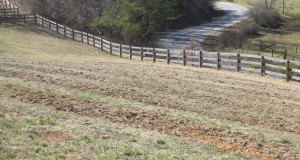
- The entire property has a three-board fence, with added wire meshing — good for keeping critters off the property, but not high enough to stop deer.
This seemed like an easier task than putting in the trellising system, but even so, we spent a fair amount of time researching deer fences over the previous month. In our division of labor, I had worked out the details on the trellis, and my wife, the Vineyard Goddess, devoted herself to the deer fence.
Traveling around area vineyards, we got a sense of the variety of fences that were being used. Some vineyards have installed metal fences as high as 10 feet, but that seemed like overkill for us.
Our property is already surrounded by a four-foot high, three-board wood fence that has a metal mesh fence attached to keep small critters out and our two Vineyard dogs in. We briefly toyed with the idea of doing something to raise the height of that fence by another four feet all around the property, but rejected that approach for two reasons.
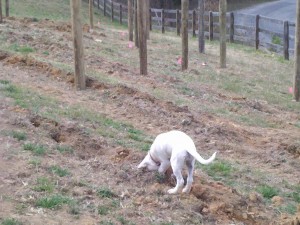
- And here Glory is demonstrating why a separate fence around the vineyard itself is absolutely essential.
First, it’s a whole lot of fence — about 1,100 feet. For about $8 a foot, we probably could have put in a fence that would be way more utilitarian than aesthetically pleasing, but this property will someday be our home, so we’re going for aesthetically pleasing. And second, while it would keep our dogs from wandering off the property, it would do absolutely nothing to keep them out of the relatively smaller vineyard area inside our property.
Phoeneix, the vineyard dog, isn’t so much of a problem by himself. He shows a certain Continue Reading–>
Bringing in the Grapes – Part III
I received a note today from Kirsty Harmon, winemaker and general manager at Blenheim Vineyards, and I thought I would draw from it to add a little bit to my last post. Kirsty was kind enough to take time out from this most difficult harvest to talk with our class, even though we had barely harvested as much, between the entire group, as a single member of a field crew would have picked in, oh, maybe 15 minutes? Remember, I did say in Part II
that we spent a lot of time staring at the vines, wanting to be sure that we didn’t add bad fruit to the lugs or leave good fruit on the ground.
In any event, we were working on half a section of Viognier that day. Kirsty had told us that they picked the first half a week earlier, due to advanced ripening at the top of the hill and indications that sour rot was starting to set in. Since it was clear that rain was on the way, Blenheim picked the first section which had ripened early, and let the rest hang on in the hope that it would continue to gain sugar and flavor.
The two types of rots that appeared on the grapes in the second section – Botrytis and sour rot – both make grapes mushy (both leak juice with a vinegary odor), and so by the time they would have made it back to the sorting table, they would have leaked all over he good fruit.
“Field sorting is labor intensive, but worthwhile,” Kirsty said. “I would say that many
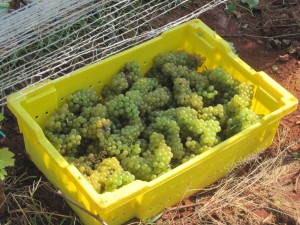
- We weren't very fast, but the fruit we added to the lugs sure looked good! Can't wait to taast the wine. 2011 Viognier.
wineries do take the time to do it though. Lots of wineries pick into bins rather than lugs, and not all wineries have the ability to sort when the fruit is picked into the half ton bins.”
You can see from the pictures in my last post how small lugs are. They are meant to bring grapes back to the crush pad or sorting table in good condition, without the weight of too many clusters at the top crushing those on the bottom.
Blenhein has almost completed its harvest. It has a small amount of Cab Franc remaining to be picked at the vineyard, and a few varieties in the Shenandoah Valley vineyards that it sources grapes from. You can bet that every winemaker and every vineyard manager will be glad to have all their fruit off the vine and into the fermentation tanks. It’s been that kind of year.
“This vintage has been the most challenging one of my career in Virginia,” said Kirsty. I think that almost every vineyard in the Commonwealth – and probably a good many in California as well – would agree.
Bringing in the Grapes – Part II
Since we don’t have grapes of our own to harvest this year, we did the next best thing, and took a class at Piedmont Virginia Community College on “Harvesting and Basic Analysis of the Must,” taught by the incomparable Gabriele Rausse.
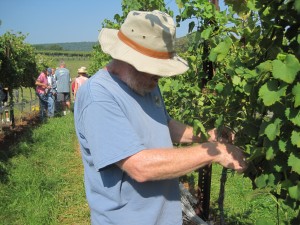
- Each grape is precious – I don’t want to send bad fruit to the crush pad, but I don’t want to waste good fruit either.
After a brief classroom lecture, we moved on to Blenheim Vineyards, where we helped (help being a relative term) pick one section of Viognier grapes. I went into this assuming that picking grapes might be the one thing about viticulture that would be so straightforward, so foolproof – SO SIMPLE! – that we could just do it, without staring at the vines, paralyzed with fear, before asking for help.
Well, no such luck.
For this particular section of the vineyard, Blenheim was “sorting in the vineyard,” which is to say, we were dropping grapes that had succumbed to disease or sour rot, or were otherwise not suitable for pressing. Most often, you bring the grapes in and sort at the crushpad, separating out the fruit that doesn’t belong in the must, and getting rid of MOG – matter other than grapes. (You’d be surprised at how many spiders make their way to the crushpad. )
This has been an exceptionally difficult year for Virginia vineyards, and Blenheim didn’t want to take a chance on letting bad fruit infect the good back at the winery. So, in addition to sorting at the crushpad, Blenheim left bad fruit on the ground in the vineyard. Continue Reading–>

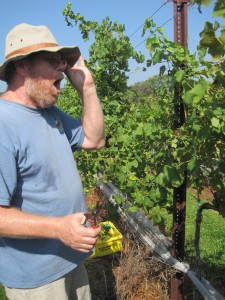



Recent Comments